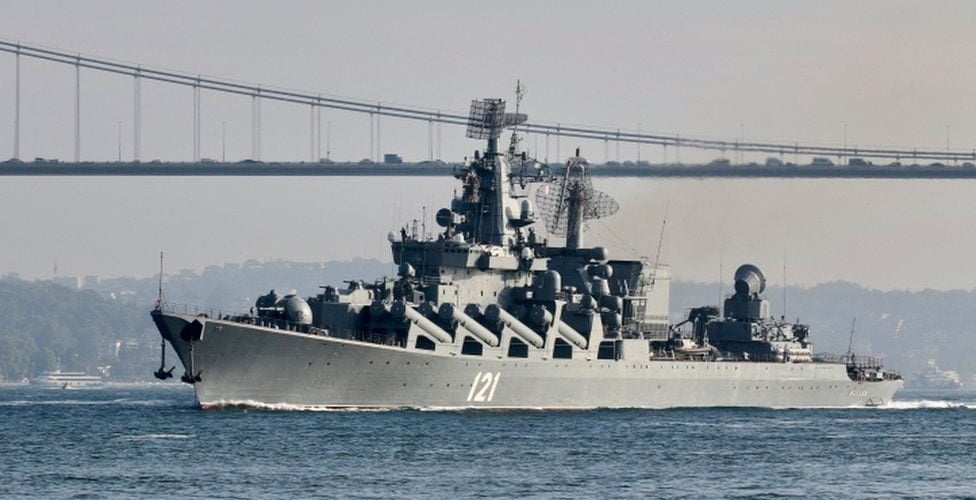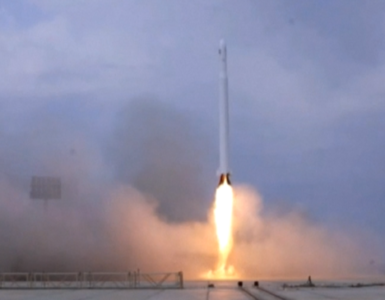Russia’s flagship Black Sea missile cruiser has been “seriously damaged” and its crew forced to evacuate, Russian state media says.
The defence ministry said ammunition on the Moskva exploded in an unexplained fire, but that the 186-metre (610 foot) vessel was still afloat.
Ukraine claims it struck the vessel with two of its Neptune missiles.
The 510-crew warship has led Russia’s naval assault on Ukraine, making it an important symbolic and military target.
Earlier in the conflict the Moskva gained notoriety after calling on Ukrainian border troops defending Snake Island in the Black Sea to surrender – to which they memorably radioed a message of refusal which loosely translates as “go to hell”.
What are both sides saying?
Overnight Russia’s defence ministry put out a statement that said “the vessel is seriously damaged. The entire crew have been evacuated”.
By Thursday afternoon the defence ministry said a fire onboard had been contained and that it would be towing the warship back to port, adding that it was still afloat.
Moscow blamed the blast on an unexplained fire, making no mention of any missile strike.
But Ukraine says it’s responsible for the attack on the cruiser, which it claims it targeted with recently-introduced Ukrainian made missile, and that at one point the cruiser even started to sink.
In a Facebook post, Ukrainian officials said Russian rescue efforts had been hampered by ammunition exploding on board and bad weather.
The BBC has not been able to verify either claim.

Imposing symbol of Russian power

We filmed the Moskva three years ago off the coast of Crimea, the peninsula Moscow annexed from Ukraine.
That day the missile cruiser was leading Navy Day celebrations. Among the Russian warships assembled there, the 12,500-tonne Moskva was an imposing sight.
Now the Russian military has admitted that the Moskva has been “seriously damaged” by a fire that caused ammunition to detonate.
No word about the cause.
In an update, the ministry later reported that the fire had been brought under control.
The incident has not been dominating news bulletins here. Russian TV’s Channel 1 led its lunchtime news with claims of “more Ukrainian soldiers surrendering” to Russian forces. The programme devoted just a few seconds to what happened to the Moskva.
Whatever the cause, the damage to the Moskva is bad news for Moscow. It is the flagship of Russia’s Black Sea fleet, and, as such, a symbol of Russia’s military power.

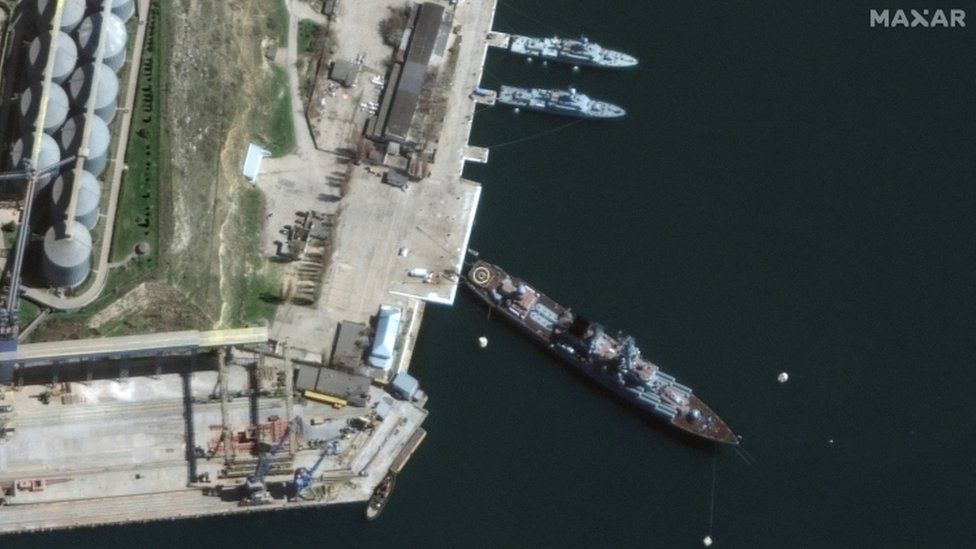 IMAGE SOURCE,MAXAR TECHNOLOGIES
IMAGE SOURCE,MAXAR TECHNOLOGIESHow important is the Moskva?
Originally built in Ukraine in the Soviet-era, the vessel entered service in the early 1980s according to Russian media.
The missile cruiser was previously deployed by Moscow in the Syria conflict where it supplied Russian forces in the country with naval protection.
It carries over a dozen Vulkan anti-ship missiles and an array of anti-submarine and mine-torpedo weapons, the reports said.
The Moskva is the second major Russian ship known to have been severely damaged since the invasion began.


What defences does the Moskva have?
The Slava-class cruiser is the third largest vessel in Russia’s active fleet and one of its most heavily defended assets, naval expert Jonathan Bentham from the International Institute for Strategic Studies told the BBC.
The cruiser is equipped with a triple-tiered air defence system that if operating properly should give it three opportunities to defend itself from a Neptune missile attack.
In addition to medium- and short-range defences, it can engage six short-range close-in weapon systems (CIWS) as a last resort.
“The Moskva should have 360-degree anti-air defence coverage. The CIWS system can fire 5,000 rounds in a minute, essentially creating a wall of flack around the cruiser, its last line of defence, ” Mr Bentham said.
If the strike is proven to have come from a missile it “raises questions over the capabilities of the modernisation of the Russian surface fleet: whether it had enough ammunition, whether it had engineering issues”.
“Essentially, you’d have thought that with that three-tiered anti-air defence system it would be very hard to hit,” the military expert added.
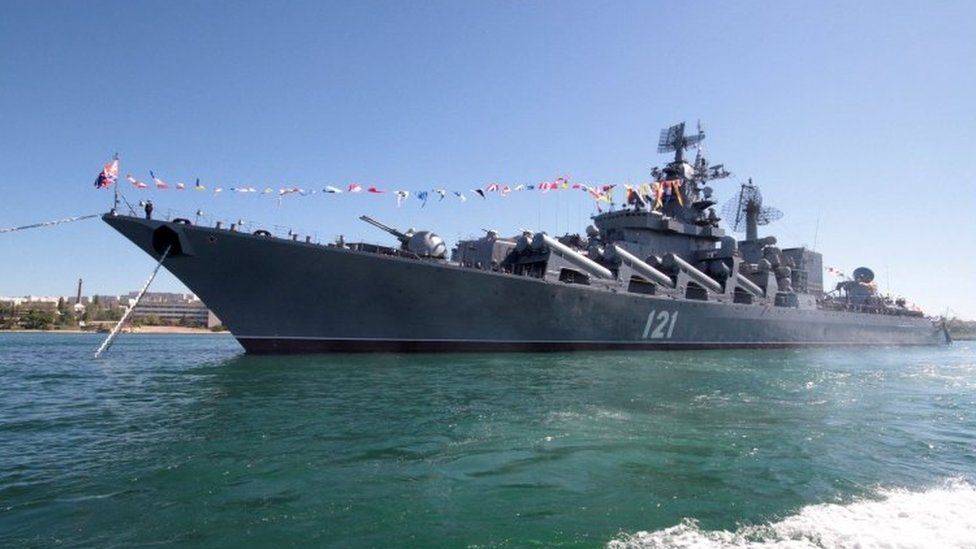 IMAGE SOURCE,REUTES
IMAGE SOURCE,REUTESNeptune missiles
Kyiv military officials say they struck the Moskva with a Ukrainian-made Neptune missile.
The cruise missile system was designed by Ukrainian military engineers in response to the growing naval threat posed by Russia in the Black Sea, following its annexation of Crimea in 2014.
According to the Kyiv Post, the Ukrainian navy only received its first delivery of the 300km-range (186 miles) Neptune missiles in March last year.
Since the invasion began Ukraine has received an influx of military aid from Western allies, including £100m worth of anti-aircraft and anti-tank missiles that the UK announced it would be sending last week.

Black Sea dominance
The warship is a “symbol of Russian naval power in the Black Sea,” Michael Petersen of the Russia Maritime Studies Institute told the BBC.
“The Moskva has been a thorn in the side of the Ukrainians since the beginning of this conflict. To see it damaged so badly…I think is going to be a real morale boost to the Ukrainians.”
 IMAGE SOURCE,MAX DELANY/AFP
IMAGE SOURCE,MAX DELANY/AFPThe Russian military has been dominant in the Black Sea since the annexation of Crimea in 2014, and has used its presence there to launch and supply the invasion.
Its Black Sea fleet has supported the war with the capacity to launch cruise missiles anywhere in Ukraine, and has been important in supporting Russian attempts to seize Mariupol.
Snake Island
In the early days of Russia’s invasion the Moskva made global headlines after it ordered a group of Ukrainian soldiers on an outpost in the Black Sea to surrender.
When the troops defiantly refused in a radio message, it was initially believed that the border troops had been killed but in fact they had been taken captive.
The soldiers were later released as part of a prisoner swap with Russia in late March and their commander was honoured with a medal by the Ukrainian military.
The tale of their bravery became such a boost to Ukraine’s morale that that the country’s postal service commemorated their encounter on Snake Island with a special illustrated stamp.
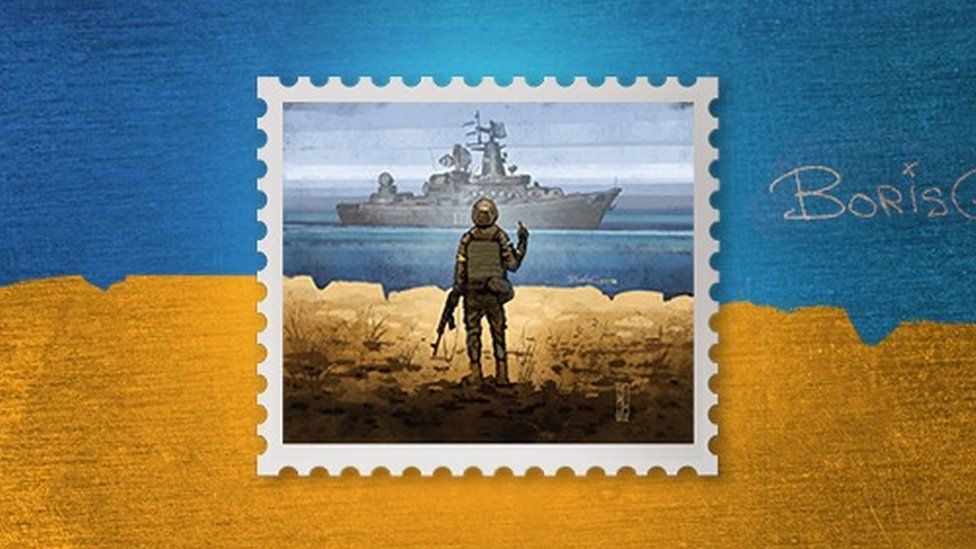 IMAGE SOURCE,UKRAINE POSTAL SERVICE
IMAGE SOURCE,UKRAINE POSTAL SERVICE
